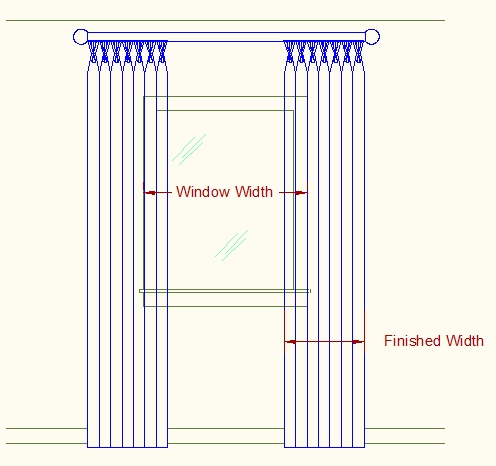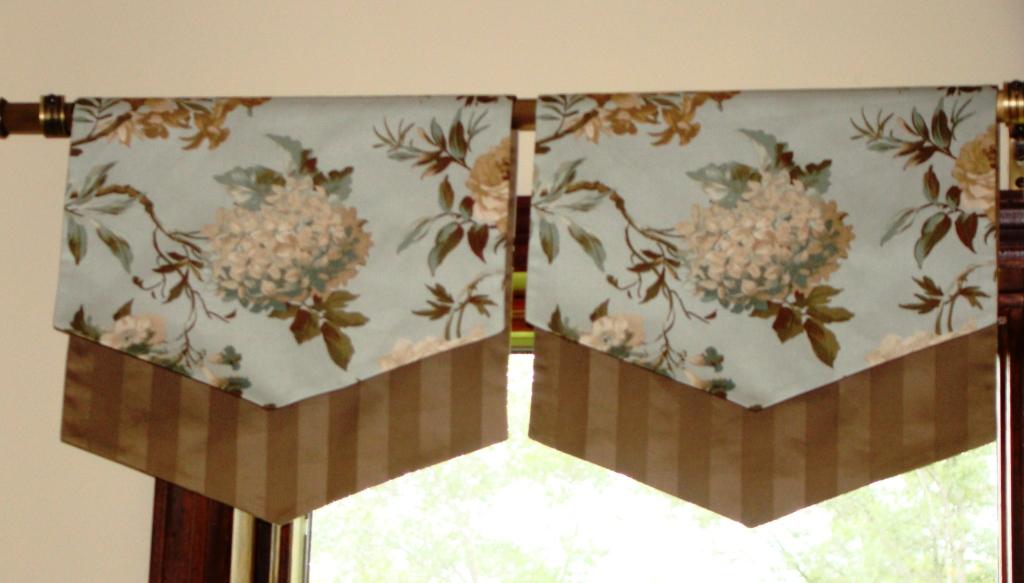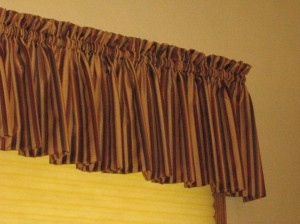If you are thinking of sewing your own drapery panels or valances, you will need to decide what “fullness” you want to use in your fabric calculations. If you have no idea what that means, read on….
The “fullness” of a window treatment is a measure of how “full” the treatment is at the window. Quite simply, it’s a way to measure how much fabric you squash on to your drapery rod.
If you made a drapery panel exactly as wide as your window, it would be flat like a bed sheet on your window. Not what you are looking for, I’m sure. Instead, we want some gather or some pleats to make the panel full and beautiful.
A typical fullness measurement is “2-1/2 times” (often abbreviated as 2-1/2 x). This means the drapery panel will be made with fabric 2-1/2 times as wide as the finished panel width or window width.
Say, for example, you would like to make a drapery that will cover your window entirely, and your window is 54″ wide (outside measurement). Take the 54″ measurement and multiply by 2.5. Your result is 135″. The fabric will need to be at least 135″ wide in order to cover your window with a 2-1/2 times fullness.
Or, perhaps you plan to make stationary drapery panels that will not cover your window. If you plan to have a finished panel width (the width your drapery panel will be when installed at the window) of 24″, with a 2-1/2x fullness your fabric would need to be at least 60″ wide.
The fullness measurement you choose depends on the weight of your drapery fabric. A thin, sheer fabric may require a 3x fullness to look rich and full at the window. On the other hand, a heavyweight fabric with lining may only require a 2x fullness for the same effect. For this shirred (gathered) cafe curtain in my bathroom, I used a 2x fullness, since the fabric is on the heavy side.
Fullness measurements are not written in stone, and can be varied for different effects and fabric widths. I chose to use 2x fullness for my bathroom curtain for a couple of other reasons (besides the fabric weight): One, I didn’t want the pattern of the fabric to get lost inside a bunch of folds (I love this fabric!). Two, I didn’t want to hassle with adding a seam to my fabric to get a fuller look. Typical home decor fabrics are 54″ wide. I used one fabric width for this curtain, but if I had wanted a fuller look, I would have needed more than one fabric width to achieve it – thus, a seam. No thanks. I’m kind of a lazy seamstress. 🙂
Despite what I said at the beginning of this article (bed sheet, anyone?), you CAN choose to create a drapery panel or valance with a 1x fullness. That is, the window treatment is made exactly the same width as your window or desired finished width. This results in a flat finished product, which can be desirable if you want to show off the fabric panel or create a more masculine or simple look. Just be sure to measure carefully if you choose this option, because you won’t have any “fudge factor” to cover a mistake, and add in any extra width for the “returns” of your rod (the part that returns back to the wall; it can add 6″ or more to your fabric width!)
Fullness is not a complicated concept, but it is oh-so-important when you are creating your own window treatments. Now that you know how to figure out your desired fullness, you can move forward with your sewing project with confidence.
Pin It




